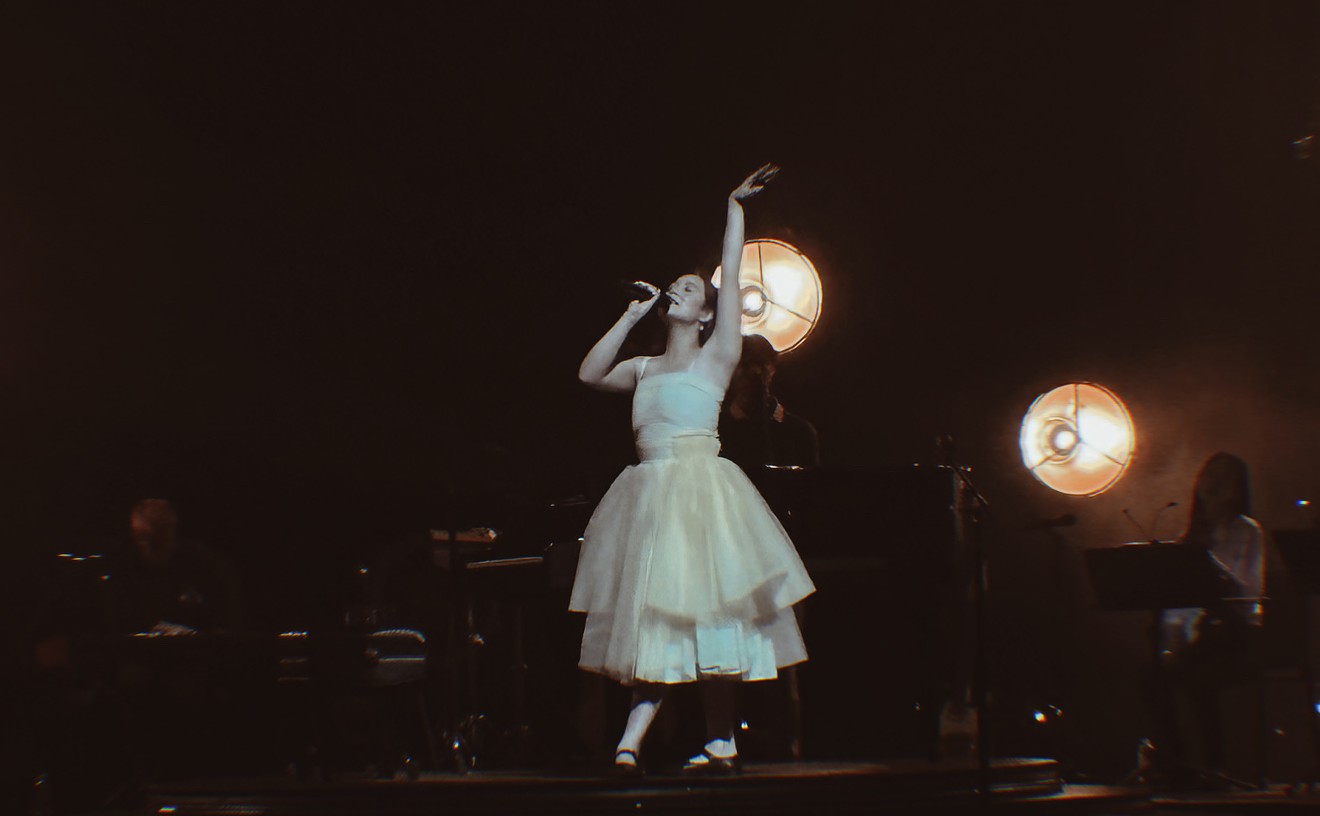Little boxes on the hillside
Little boxes made of ticky-tacky
Little boxes on the hillside
Little boxes all the same
Not much of a legacy there, to have a wry commentary on postwar suburban conformity turned, ironically enough, into embellishment for a story on making your home conform to design standards. Reynolds died of kidney failure in 1978, so she didn't live to see much of that transformation, which appropriately enough happened as the folk tradition morphed from a showcase for worldly wisdom and righteous protest into self-involved and overearnest singer-songwriter-ing--a sad, slow slide into irrelevance you might call the Jackson Browne Syndrome. Graced with a quick wit, an almost stubborn optimism, and an interest in being both specific and universal, Reynolds had a prolific career that was a lesson in what should've worked during the folk-music revival of the '60s. Like her contemporaries, Reynolds was topical, yanking many of her lyrical ideas straight from the San Francisco Chronicle, but she was also funny and a fine writer of children's songs. Her approach to some extent isolated her from the likes of more notorious folkies like Tom Paxton, Phil Ochs, and Bob Dylan, whose severe spite and aloofness were often woven deep into their music.
"Simplicity," says Pete Seeger of Reynolds' main strength as a songwriter. "As with Woody Guthrie, simplicity. 'Little Boxes' and 'God Bless the Grass' are so supremely simple, it's extraordinary--they hit the mark in all sorts of places. You might consider that a very simple song is like a basketball backboard. It bounces back new meanings as your life's experiences are bounced against it. That's why a simple old spiritual, some 150 years after some cotton-picking slave wrote it, is now world-famous."
Born at the turn of the century in San Francisco, though she lived most of her life in Berkeley, Reynolds began her music career in 1947, chasing down Seeger at a Los Angeles hootenanny. "She said, 'I'd like to try doing what you do, making up songs and singing them,'" Seeger recalls. "And I said, 'Well, you don't get rich, but you meet the best people in the world.' And I thought to myself, 'Gee, she's kind of old to get started.' I was 28, and she was 47, 19 years older than I was. I had a lot to learn, because in the next 25 to 30 years, she just turned out one great song after another."
If Reynolds is still remembered today, it's due in large part to Seeger, who has routinely performed her songs. Three of them--"Mrs. Clara Sullivan's Letter," "From Way Up Here," and "Little Boxes"--were part of the set for his 1963 Carnegie Hall concert, and "Little Boxes" is still often mistakenly attributed to him. Joan Baez and Judy Collins scored modest hits with Reynolds' protest songs ("What Have They Done to the Rain" and "It Isn't Nice," respectively), and her music has quietly insinuated itself into the repertoires of everyone from Harry Belafonte to Charlie Louvin to Marianne Faithfull.
But many of the records Reynolds made for Folkways, Columbia, or her own Cassandra label are out of print, and until recently all but one were unavailable on CD. This year, however, marks what would have been Reynolds' hundredth birthday, and the tributes have begun pouring in: Rosalie Sorrels has finished a tribute album, No Closing Chord, set for release this summer; and Ear to the Ground: Topical Songs 1960-1978, the first of two CD collections of Reynolds' songs compiled by Sorrels, was recently released on Folkways.
Sorrels grew up in Salt Lake City, and as Reynolds chased down Seeger in 1947, Sorrels chased down Reynolds after moving to the Bay Area in 1967. "Malvina went out of her way to reach young people and open their heads up," says Sorrels, who now lives outside Boise, Idaho. "She used to do that a lot--she tried to find out what they thought and reach across that stretch of time. I was 33 years younger than Malvina, and I took it as a great gift that she would befriend me." Like Seeger, Sorrels made Reynolds' songs a regular part of her sets, though getting a high-profile collection of Reynolds' songs released was a long time coming. "I've been trying to get somebody to let me do this for 10 years, and nobody thought it was commercially viable," Sorrels says.
The 23 songs collected for Ear to the Ground present a performer who doesn't neatly fit into our inherited idea of what a folk singer should be. First is Reynolds' voice: big, brassy, time-worn, and not always on key. Nobody would mistake Malvina Reynolds for any sort of vocal stylist; one early critic said Bob Dylan's voice sounded like a cow stuck in a fence, but Reynolds' isn't even that distinguished--she sounds merely grandmotherly, and when she sang "The Little Mouse," based on a true story of a mouse shutting down the Buenos Aires banks and stock exchange by gnawing through the computer wires, she pronounces the name of the city "Buh-way-nuss Eye-reez." Yet it's that aw-shucks voice-of-the-common-people approach that let her--in her mid-70s at the time--get rousing applause with the song's key line: "Hooray for the little mouse / That fucked up the clearinghouse!"
Hooray for the little mouse indeed, but you know what? The poor thing probably got electrocuted. That plays into Reynolds' other legacy, that of the unrepentant optimist, where "love is something if you give it away" ("Magic Penny") and even if "this old world is mean and cruel / Still I love it like a fool." Even when she was being harshly ironic, she was never that harsh: "Boraxo," a song about the 1969 tear gassings at People's Park--when a flip then-California Gov. Ronald Reagan said he'd wash the blood off his hands with that brand of soap--doesn't finger Reagan explicitly.
Reynolds' is a vision that runs contrary to our inherited notion of a folk singer, naming names and shouting her anger. But those charged with preserving her legacy say that was her greatest asset--and just as valid as any other approach. "I certainly picked up her songwriting ideas, particularly the idea of keeping it particular," says Reynolds' daughter Nancy Schimmel, a Berkeley songwriter herself. "She was writing about an incident instead of the abstract, and there are people who will talk about that kind of influence. Her influence may not always be visible, but it's there." Tackling that question, Seeger opts for Reynolds' own words, the start of a poem she wrote: "If this world survives (and every other day I think it might) / In good part it will be because of the great souls in our community."
If that sensibility seems overly romantic today, then part of the blame for our changing perceptions of folk music can be laid at the feet of the late Harry Smith. While Reynolds was living in the Berkeley flats, chasing down Seeger, and studying at UC Berkeley, Smith was living in a cluttered apartment in the Berkeley hills, on Panoramic Way, conning people out of their old 78s and starting an ambitious project that would essentially define folk music as we know it today. Artist, filmmaker, music fan, and anthropologist, the time Smith spent in the Bay Area in the late '40s would lead to the creation of the three-volume Anthology of American Folk Music, released in 1952.
Broken roughly into the categories "Ballads," "Social Music," and "Songs," the Anthology betrayed a wealth of research, but it would be a mistake to call it an act of musicology. Smith had too much fun with the thing, from the fake newspaper headlines he used for each song's description to the way the songs were arranged, talking to each other instead of walking a narrow historical path. In carefully picking songs from a patch of just five years (1926 to 1931), Smith covered just about every feeling and concept that songwriters wrestle with today.
Mainly, though, the songs focus on stuff like loss and hard work and tested faith, subjects at the heart of the new Harry Smith's Anthology of American Folk Music, Volume Four, a long-rumored collection, finally released on Revenant, that dives deeper into the musical response to the Great Depression. It would seem the much-celebrated and Grammy-winning reissue of the original Anthology, which sold over 30,000 copies, inspired a rush to get the fourth volume out, but little related to Smith works so simply. "Several years ago Harry Smith Archives passed us a somewhat mystery-shrouded tape containing the Volume Four tracks, a number of which had yet to be identified as to artist and title," says Revenant spokesperson John DeFore. "We and HSA began trying to uncover more about the background and, two or three short years later, here we are. In 'Revenant time,' our response was practically instantaneous."
The volume has the imprint of Smith's fascination with spectral voices slogging their way toward some version of truth: the oddly detached, but not resigned, sound in Blind Alfred Reed's voice when he sang "How Can a Poor Man Stand Such Times and Live?" in 1929, or Minnie Wallace stomping her anger out at "The Cockeyed World" in 1935. "Anything Harry supposedly collaborated on with others can be immediately ruled out as legitimate, of course," says DeFore. "Collaboration was not in Harry's nature." Looking at the Anthology that way, with Smith as the sole author passing down messages, the messages got passed oddly, mutating and finding themselves in weird corners of music. Sister Clara Hudmon's "Stand by Me" shades Ben E. King's later hit; Robert Johnson's "Last Fair Deal Gone Down" got telegraphed not to folkies but guitar students; the Carter Family's "No Depression in Heaven" would spawn the sensibility (and title) for a bad album by a good band, Uncle Tupelo, that would then inspire a whole genre mucking with tradition throughout the '90s.
That isn't the same simple path of songs passed down whole from generation to generation, but it's no better or worse than Smith's intent, and probably even the way he would've liked it. If you want to hear the past, you might as well listen to the present. As he told interviewer John Cohen in 1968: "I don't think people should spend too much time fiddling with old records--it's better to switch on the radio."










